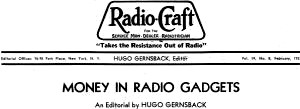Editorial: Money in Radio Gadgets
|
|
Substitute "cellphone" for "radio" in this title ("Money in Radio Gadgets") and editorial by Hugo Gernsback and it would fit right in with today's market of wondrous gadgetry. Prescient as always, Mr. Gernsback describes in this 1933 issue of Radio-Craft magazine, among other things, what we now refer to as energy harnessing to power ancillary devices and props. He also recommends a scheme for causing 'dancing dolls' on the surface of a table vibrated and mobilized by the sonic waves of a large speaker - a lot like the way years later vibrating football games were made (remember them?) where the men danced randomly across the painted metal playing field. It sounded like a pair of electric hair clippers running. Gernsback imagines the potential for a hand-held remote control device for remotely controlling your radio from the comfort of your easy chair. Here is the "Radio Gadgets" editorial by Hugo Gernsback from the October 1947 issue of Radio-Craft magazine! Money in Radio Gadgets
The dictionary does not define the word "gadget." It is supposed to be a mechanical appliance or accessory, which may, or may not, be a necessity. The radio industry is turning out an increasing number of such gadgets, and many of them have acquired a wide sale; a number of them may even be termed necessities. It all depends upon the point of view, because frequently a gadget may become an important radio accessory. These gadgets are of importance, today, because they give new outlets both to those branches of the radio manufacturing industry that are equipped to turn out such devices, and to the radio Service Man who installs them. These gadgets are important, and should be taken most seriously by the radio trade because anything that enhances the radio owner's interest in his set is, after all, important. When a radio owner has a radio set in his home which he does not use, he becomes a direct loss to the entire industry. Give him something to either amuse himself, amuse his children, or get better radio reception through the means of his radio set, and immediately that man becomes again a live asset to the industry. It is surprising how little attention the radio industry has paid to the toy radio gadget. I was, perhaps, the first one to point this out in an article published in one of my radio magazines in 1925. This particular article of mine showed how, by means of a loudspeaker arrangement, dolls with wire feet were made to dance on a large diaphragm. The loudspeaker unit, of course, was plugged into the radio set, and the dolls danced in unison with the vibrations of the 6-inch diaphragm. Few engineers and few experimenters seem to understand that every radio set actually generates a small amount of power on its output side. Some manufacturers have already recognized how this power can be utilized, and are now putting out a number of radio toys. A recent example came to my attention where a papier-mâché dog would wag its tongue when connected to the output side of the radio set. Another novelty, which is gaining vast popularity, is not plugged into the radio set, but works by means of a small microphone placed in front of a radio. This particular toy is a dancer which dances a jig to the tune of the sound vibrations issuing from the loudspeaker, transmitted to the little microphone, which in turn energizes a number of relays; this operates the dancer. The possibilities in this particular line are, of course, tremendous; and during the next two years we will see a veritable avalanche of such toys, instructive and otherwise. I predict that an entirely new branch of radio will be created in this particular field. Then we have other types of gadgets. Right now, there seems to be a small boom in miniature microphones, which are connected to the detector of your radio set. You are then supposed to broadcast from a concealed point to your friends, giving all sorts of amusing fake announcements over your own radio without benefit of the broadcast station. It is said to be an excellent entertainer. On good authority, it is understood that close to half a million of these little microphones will be sold during this year. Then, we have the "radio" clock, a most useful gadget. In my home, such a radio clock promptly turns on the radio at a pre-determined hour every morning, and I am awakened by radio unfailingly, and better than could be done by means of, a plain alarm clock. Your ears becomes used to an alarm clock so that after a while you no longer hear it. But the radio program, every morning, is different. It may be talk or music, or what not. There are a number of excellent clocks of this kind on the market, and they make valuable adjuncts to any man's radio set. Next on the list are remote control attachments that make it possible for you to sit in a chair at the other end of the room, tune your radio and control the volume all from the same gadget. While these remote control outfits have not revolutionized the business during the past few years, the reason probably was that the price was too high. A low-priced remote control gadget would certainly prove a good seller. Then, we have a host of new trick aerials which have been flooding the market in the past few years. Many of these have been out and out fakes, which every radio man would immediately spot. There are, however, a number of notable exceptions. High gain sets, for instance, do not need outdoor antennas in all cases. Some recent gadgets are intended to be placed underneath your home telephone receiver, the idea here is that we have an insulated plate upon which the telephone is placed. This plate goes to the aerial binding post of your set. The plate being insulated, gives a con-denser action to the bottom of the telephone set, and it makes a fair interior antenna. It suffers from the disad-vantage that every time you lift up the telephone receiver you get a loud and noisy click in your set. More important and vastly better, are new shield leads for outdoor antennas, very much in vogue now. These are supposed to eliminate the usual man-made static, and by means of a small transformer attached to the upper part of the antenna, they actually succeed in cutting down a great deal of man-made static. This particular type is used for broadcast waves. Another type, whereby the aerial is transposed, by means of transposition blocks, is especially adapted for short waves, and in actual practice is most efficient. All of these devices are interesting, particularly to the Service Man, and those who have to make a living from radio merchandise. Radio Service Men should be particularly interested in all such new devices because they mean a new source of income which becomes increasingly important as time goes by. There are many reasons why radio set owners become dissatisfied with their radio sets, and it is always a good idea to rekindle their interest by means of new devices. Incidentally, the profit on these gadgets is as great as the profit on other important accessories. Frequently, extraordinary good sales are reported by various Service Men who have gone into this branch of radio.
Posted October 7, 2020 |
|




